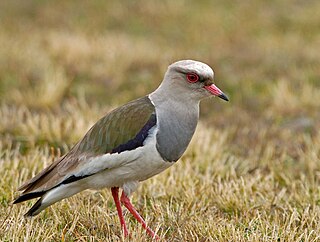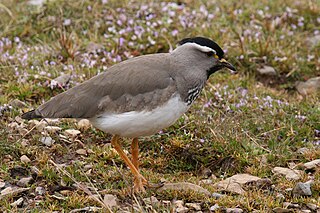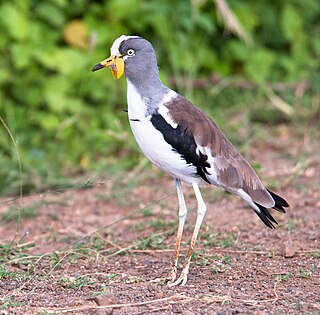 W
WVanellus is the genus of waders which provisionally contains all lapwings except red-kneed dotterel, Erythrogonys cinctus. The name "vanellus" is Latin for "little fan", vanellus being the diminutive of vannus. The name is in reference to the sound lapwings' wings make in flight.
 W
WThe African wattled lapwing, also known as the Senegal wattled plover or simply wattled lapwing, is a large lapwing, a group of largish waders in the family Charadriidae. It is a resident breeder in most of sub-Saharan Africa outside the rainforests, although it has seasonal movements.
 W
WThe Andean lapwing is a species of bird in the family Charadriidae. It is found in Argentina, Bolivia, Chile, Colombia, Ecuador, and Peru. Its natural habitats are subtropical or tropical high-altitude grassland, rivers, swamps, and pastureland.
 W
WThe banded lapwing is a small to medium-sized shorebird, found in small parties or large flocks on bare ground in open grasslands, agricultural land and open savannah. It is native to Australia and in the past considered as a game bird for hunting. Population estimate is 25 000 - 1 000 000. Other names include banded, black-breasted, brown flock and plain plover.
 W
WThe black-headed lapwing or black-headed plover is a large lapwing, a group of largish waders in the family Charadriidae. It is a resident breeder across sub-Saharan Africa from Senegal to Ethiopia, although it has seasonal movements. It lays two or three eggs on a ground scrape.
 W
WThe black-winged lapwing or greater black-winged lapwing is an east African species that is found from the Ethiopian highlands in the north to central Kenya, and again at middle to coastal elevations in eastern South Africa. It is a habitat specialist of short grass in well-watered temperate grasslands. They may move about locally to find ideal situations, often at night. In their tightly grouped flying flocks they resemble plovers.
 W
WThe blacksmith lapwing or blacksmith plover is a lapwing species that occurs commonly from Kenya through central Tanzania to southern and southwestern Africa. The vernacular name derives from the repeated metallic 'tink, tink, tink' alarm call, which suggests a blacksmith's hammer striking an anvil.
 W
WThe brown-chested lapwing is a species of bird in the family Charadriidae. It resides year-round in a narrow strip of land from southwestern Nigeria to northeastern Democratic Republic of the Congo; its wintering range extends toward Lake Chad, Lake Victoria and northern Zambia.
 W
WThe crowned lapwing, or crowned plover, is a bird of the lapwing subfamily that occurs contiguously from the Red Sea coast of Somalia to southern and southwestern Africa. It is an adaptable and numerous species, with bold and noisy habits. It is related to the more localized black-winged and Senegal lapwings, with which it shares some plumage characteristics.
 W
WThe grey-headed lapwing is a lapwing species which breeds in northeast China and Japan. The mainland population winters in northern Southeast Asia from northeastern India to Cambodia. The Japanese population winters, at least partially, in southern Honshū.
 W
WThe Javan lapwing also known as Javanese lapwing and Javanese wattled lapwing is a wader in the lapwing family.
 W
WThe long-toed lapwing is a species of bird in the family Charadriidae. It is found in Angola, Botswana, Burundi, Cameroon, Chad, Democratic Republic of the Congo, Ethiopia, Kenya, Malawi, Mozambique, Namibia, Nigeria, Rwanda, South Africa, Sudan, Tanzania, Uganda, Zambia, and Zimbabwe.
 W
WThe masked lapwing is a large, common and conspicuous bird native to Australia, particularly the northern and eastern parts of the continent, New Zealand and New Guinea. It spends most of its time on the ground searching for food such as insects and worms, and has several distinctive calls. It is common in Australian fields and open land, and is known for its defensive swooping behaviour during the nesting season.
 W
WThe northern lapwing, also known as the peewit or pewit, tuit or tew-it, green plover, or pyewipe or just lapwing, is a bird in the lapwing subfamily. It is common through temperate Eurosiberia.
 W
WThe pied plover, also known as the pied lapwing, is a species of bird in the family Charadriidae. It is a bird of least concern according to the IUCN and can be found in northern South America. The species name cayanus refers to Cayenne, the capital of French Guiana, where the pied plover can be found.
 W
WThe red-wattled lapwing is an Asian lapwing or large plover, a wader in the family Charadriidae. Like other lapwings they are ground birds that are incapable of perching. Their characteristic loud alarm calls are indicators of human or animal movements and the sounds have been variously rendered as did he do it or pity to do it leading to the colloquial name of did-he-do-it bird. Usually seen in pairs or small groups and usually not far from water they sometimes form large aggregations in the non-breeding season (winter). They nest in a ground scrape laying three to four camouflaged eggs. Adults near the nest fly around, diving at potential predators while calling noisily. The cryptically patterned chicks hatch and immediately follow their parents to feed, hiding by lying low on the ground or in the grass when threatened.
 W
WThe river lapwing is a lapwing species which breeds from the Indian Subcontinent eastwards to Southeast Asia. It range includes much of northern and northeastern India, and extends through Southeast Asia to Vietnam. It appears to be entirely sedentary. Formerly also called spur-winged lapwing, this name is better reserved for one of the "spur-winged plovers" of old, Vanellus spinosus of Africa, whose scientific name it literally translates. The masked lapwing of Australasia was at one time also called "spur-winged plover", completing the name confusion - particularly as none of these is a plover in the strict sense.
 W
WThe Senegal lapwing or lesser black-winged lapwing is a species of bird in the family Charadriidae. It is found in Angola, Burundi, Cameroon, Republic of the Congo, Democratic Republic of the Congo, Ivory Coast, Gabon, Gambia, Ghana, Guinea, Kenya, Liberia, Malawi, Mali, Mozambique, Nigeria, Rwanda, Senegal, Sierra Leone, Somalia, South Africa, Swaziland, Tanzania, Togo, Uganda, Zambia, and Zimbabwe.
 W
WThe sociable lapwing or sociable plover is a critically endangered wader in the lapwing family of birds. The genus name is Medieval Latin for a lapwing and derives from vannus a winnowing fan. The specific gregarius is Latin for "sociable" from grex, gregis, "flock".
 W
WThe southern lapwing is a wader in the order Charadriiformes. It is a common and widespread resident throughout South America, except in densely forested regions, the higher parts of the Andes and the arid coast of a large part of western South America. This bird is particularly common in the basin of the Río de la Plata. It has also been spreading through Central America in recent years. It reached Trinidad in 1961 and Tobago in 1974, and has rapidly increased on both islands, sporadically making its way North to Barbados where one pair mated, nested and produced chicks in 2007.
 W
WThe spot-breasted lapwing is a species of bird in the family Charadriidae. It is endemic to the Ethiopian highlands.
 W
WThe spur-winged lapwing or spur-winged plover is a lapwing species, one of a group of largish waders in the family Charadriidae.
 W
WThe white-crowned lapwing, white-headed lapwing, white-headed plover or white-crowned plover is a medium-sized wader. It is resident throughout tropical Africa, usually near large rivers.
 W
WThe white-tailed lapwing or white-tailed plover is a wader in the lapwing genus. The genus name Vanellus is Medieval Latin for a lapwing and derives from vannus a winnowing fan. The specific leucurus is from Ancient Greek leukouros, "white-tailed".
 W
WThe yellow-wattled lapwing is a lapwing that is endemic to the Indian Subcontinent. It is found mainly on the dry plains of peninsular India and has a sharp call and is capable of fast flight. Although they do not migrate, they are known to make seasonal movements in response to rains. They are dull grey brown with a black cap, yellow legs and a triangular wattle at the base of the beak. Like other lapwings and plovers, they are ground birds and their nest is a mere collection of tiny pebbles within which their well camouflaged eggs are laid. The chicks are nidifugous, leaving the nest shortly after hatching and following their parents to forage for food.